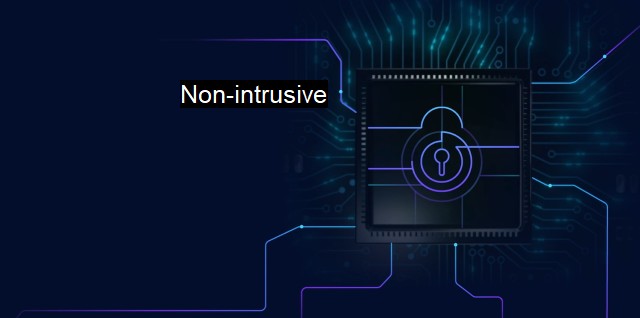What is Non-intrusive?
The Importance of Non-Intrusive Cybersecurity Solutions: Keeping Networks Safe Without Disruptions or False Alarms
"Non-intrusive" is a term that is often used in the fields of cybersecurity and antivirus software development to describe technologies, measures, policies, or practices that minimize their interference with user activities and system performance while carrying out their intended functions - such as preserving data privacy, ensuring system security, and safeguarding against potential threats. This term emphasizes a critical feature that both users and cybersecurity professionals value. It reflects the delicate balance required in designing effective cybersecurity tools – which must be powerful enough to detect and repel threats, yet discreet enough so as not to disturb the user or hinder the functionalities of the high-tech equipment.In the cybersecurity space, a non-intrusive system delicately monitors and protects a user's activities and data without impairing the system's performance or the user's experience. It is akin to an invisible shield, working in the backdrop while you continue browsing the internet, downloading documents, or sharing files. This level of transparency and uninvasiveness is crucial for user compliance, acceptance, and overall satisfaction with security software. It also prevents interruptions that could lead to reduced productivity or performance.
Many popular antivirus programs now embody this non-intrusive philosophy, adopting silent or gaming modes that suppress notifications and updates while the user is engaged in full-screen activities, minimally impacting system resources. This ensures that the software does not slow down performance or become a source of distraction for the user. Such intelligent designs can prioritize tasks, understand when a system is idle, or discern the importance of a task - moving heavy-processing tasks to off-peak periods to maintain optimal performance.
The term "non-intrusive" should not give the impression that such measures are passive or ineffective. Non-intrusive cybersecurity solutions can be incredibly robust and sophisticated, utilizing advanced mechanisms such as machine learning and artificial intelligence to understand user patterns, detect abnormalities, and predict potential risks. They actively work to encrypt data, ensure secure connections, and protect against harmful downloads and leaks— all carried out in a seamless, minimally disruptive way.
Non-intrusive cybersecurity relates to both the creation and enforcement of policies that enable secure, uninhibited access to various digital interfaces and platforms. For instance, implementing multi-factor authentication can be non-intrusive yet adds an additional layer of access security. Also, organizations might adopt non-intrusive access controls, like biometric authentication, which facilitate swift and secure validity checks while minimally impacting daily work routines.
In striking this balance between security and user experience, it is essential to understand that non-intrusive measures should not compromise security. Developers make concessions to prioritize system performance and user preferences, but these modifications should still ensure optimal protection from potential threats.
Privacy is another critical factor intertwined with non-intrusive cybersecurity. With the advent of interconnected devices and the Internet of Things (IoT), there is an increased risk to personal data vulnerabilities. Hence, non-intrusive cybersecurity methods need to safeguard personal data whilst also respecting users' privacy rights. They should provide secure environments for data flow, reducing the risk of confidentiality breaches, but carried out in a manner where data access, manipulation and control align with best practices on user-privacy.
Non-intrusive cybersecurity and antivirus mechanisms make it possible for today's technologically-dependent world to continuously enjoy the pleasures and benefits of digitization while upholding the highest defensive measures. By limiting user interferences and maintaining high levels of device performance, non-intrusive systems subtly offer protective layers, ensuring a safer and more secure digital environment. It does so by working in the background, protecting your systems without slowing you down, and ensuring that online activities are secure and refinements are ongoing in the near invisible war against cyber threats.

Non-intrusive FAQs
What does non-intrusive mean in the context of cybersecurity and antivirus?
Non-intrusive in cybersecurity and antivirus refers to a method of protecting against threats that does not interfere with the normal operation of a system. Non-intrusive solutions do not require extensive permissions or access to sensitive data and do not disrupt user workflows.How does non-intrusive antivirus software differ from other antivirus products?
Non-intrusive antivirus software is designed to protect against cyber threats without causing performance issues, disrupting user workflows, or requiring extensive permissions. This differs from other antivirus products that may be more intrusive, require more access to sensitive data, and can cause system slowdowns.What are the benefits of using a non-intrusive antivirus solution?
Using a non-intrusive antivirus solution can provide several benefits, such as improved system performance, increased productivity, reduced system downtime, and improved user experience. Non-intrusive solutions are also less likely to cause conflicts with other software and have a lower risk of false positives.Are there any downsides to using a non-intrusive antivirus solution?
While non-intrusive antivirus solutions offer many benefits, there are some potential downsides. Non-intrusive solutions may not provide as robust protection as more intrusive options, and they may not be as effective against certain types of threats. Additionally, some users may prefer antivirus solutions that offer more control or transparency over the scanning and protection processes.| | A | | | B | | | C | | | D | | | E | | | F | | | G | | | H | | | I | | | J | | | K | | | L | | | M | |
| | N | | | O | | | P | | | Q | | | R | | | S | | | T | | | U | | | V | | | W | | | X | | | Y | | | Z | |
| | 1 | | | 2 | | | 3 | | | 4 | | | 7 | | | 8 | | |||||||